#الطبيخ
Explore tagged Tumblr posts
Text
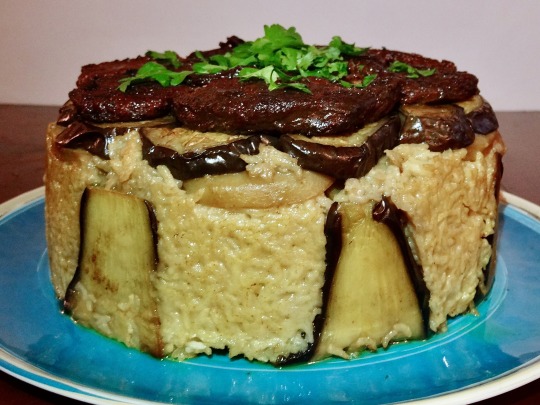
[ID: A wide cylindrical pile of rice, eggplants, and 'lamb' on a serving platter, garnished with parsley. End ID]
مقلوبة / Maqluba
مَقْلُوبَة ("maqlūba," "upside down" or "turned over") is a Levantine casserole in which spiced meat, fried vegetables, and rice are arranged in a pot and simmered; the entire pot is then inverted onto a serving tray to reveal the layered ingredients. Maqluba historically uses lamb and eggplant, but modern recipes more often call for chicken; tomato, cauliflower, potato, bell pepper, and peas are other relatively recent additions to the repertoire.
A well-made maqluba should be aromatic and highly spiced; the meat and vegetables should be very tender; and the rice should be cohesive without being mushy. A side of yoghurt gives a tangy, creamy lift that cuts through and complements the spice and fat in the dish.
Maqluba emphasizes communal eating and presentation. It is usually eaten during gatherings and special occasions, especially during Ramadan—a month of sunrise-to-sunset fasting which celebrates the revelation of the Qu'ran to the prophet Mohammad. The pot is sometimes flipped over at the table for a dramatic reveal.
History
Many sources cite Muhammad bin Hasan al-Baghdadi's 1226 Kitāb al-ṭabīkh (كتاب الطبيخ لمحمد بن حسن البغدادي) as containing the first known reference to maqluba. However, the recipes for "maqluba" in this book are actually for small, pan-fried patties of spiced ground meat. [1] The dish is presumably titled "maqluba" because, once one side is fried, the cook is instructed to turn the patties over ("أقلب الوجه الآخر") to brown the other; the identical name to the modern dish is thus coincidental.
References to dishes more like modern maqluba occur elsewhere. A type of مغمومة ("maghmūma," "covered" dish), consisting of layers of meat, eggplant, and rice, covered with flatbread, cooked and then inverted onto a serving plate, is described in a 9th-century poem by إبراهيم بن المهدي (Ibrāhīm ibn al-Mahdī):
A layer of meat underneath of which lies a layer of its own fat, and another of sweet onion, another of rice, Another of peeled eggplant slices, each looking like a good dirham honestly earned. [...] Thus layered the pot is brought to a boil first then enclosed with a disc of oven bread. On the glowing fire it is then put, thus giving it what it needs of heat and fat. When fully cooked and its fat is well up, turn it over onto a platter, big and wide. (trans. Nawal Nasrallah) [2]
These sources are both Iraqi, but one story holds that maqluba originated in Jerusalem. صلاح الدين الأيوبي (Ṣalāḥ ad-Dīn al-Ayyūbi; "Saladin"), after capturing the city from the Crusaders and reinstating Muslim rule in 1187, was served the dish, and was the first to describe it with its current name. Before this point, the Jerusalem specialty had supposedly been known as "باذنجانية" ("bāḏinjānīyya"), from "باذنجان" "bāḏinjān" "eggplant" + ية- "-iyya," a noun-forming suffix.

[ID: The same dish shown from directly above. End ID]
In Palestine
Maqluba is often invoked in the context of Palestinian strength and resistance, in defiance of its occasional description as an "Israeli" dish. Palestinian magazine writer Aleeya Rizvi reflects:
In the wake of the recent [2023] war in Gaza, our culinary endeavors, particularly in crafting and sharing traditional Palestinian dishes like Maqluba, represent a conscious effort to contribute to the preservation and resilience of Palestinian culture. In a time when cultural heritage is under threat, preparing and enjoying these time-honored recipes becomes more than a mere culinary activity; it transforms into a deliberate act of cultural continuity and solidarity.
Maqluba also has a more specific association with physical resistance against the backdrop of increased settler and police violence against Palestinians, including regular Israeli raids and attacks on the جامع الأقصى ("Jāmi' al-Aqṣā"; al-Aqsa mosque), during Ramadan.
The holiest month in the Islamic calendar, Ramadan is given over to fasting, prayer, and reflection; people gather together in homes and mosques to break their fast after sunset, and spend entire nights in mosques in worship. Khadija Khwais and Hanady Al-Halawani used to serve maqluba for افطار ("ifṭār," fast-breaking meal) in the Al-Aqsa mosque, until Israeli occupation authorities banned them from the mosque for "incitement."
In response, starting in 2015, Al-Halawani and other volunteer مرابطين ("murābiṭīn," lit. "holy people," guardians of the mosque) stationed themselves on the ground outside the mosque's gate (باب السلسلة; Bāb as-Silsila, "chain gate") to prepare and serve maqluba. Those who were banned from entering the mosque broke their fast and prayed at the mosque's gates, and in the nearby alleys of the Old City. The same year saw Israeli security personnel and settlers attack Palestinian protestors and guardians outside and inside the mosque with tear gas and stun grenades.
For Al-Halawani, the serving of maqluba at the al-Aqsa gates symbolizes "defiance, steadfastness, and insistence on continuing the fast [...] in spite of the occupation’s practices." The "Maqluba at al-Aqsa" ritual "has become one of the most disturbing Palestinian scenes for the occupation forces," who associate it with the defense of "Palestinian heritage" and the intent to "motivate worshipers and murabitin to repel incursions into the mosque." (Al-Halawani has been arrested, threatened, beaten, and detained by Israeli police multiple times for her role as a defender of Al-Aqsa. She was among the prisoners freed in trades between Israel and Hamas in December 2023.)
In 2017, occupation forces installed metal detectors, electronic gates, metal barriers, and police cameras to surveil worshipers following a shoot-out at one of al Aqsa's gates. Hundreds of protesters refused to enter the mosque until the repressive measures were removed, instead gathering and praying in its courtyard; surrounding families bolstered the sit-ins by serving food and drink. When the gates were dismantled, over 50,000 people gathered to eat maqluba in celebration, picking up on the earlier association of the dish with Saladin's victory (and its resultant alternate name, "أكلة النصر," "ʔakla an-naṣr," "victory meal").
The name "maqluba," meaning "upside-down" or "inverted," may be associated with victory and resistance as well. Fatema Khader noted in 2023 that the method of serving maqluba was a "symbolic representation of how Israeli policies and decisions against Palestinians will be flipped on their heads and become rendered meaningless." It is also relevant that maqluba is meant to be served to large groups of people, and can thus be linked, symbolically and literally, to solidarity and communal resistance.
This year in Gaza, Palestinians show steadfast optimism as they paint murals, hang lanterns, buy sweets, hold parties, and pray in groups amongst the rubble where mosques once stood. But despite these efforts at creating joy, the dire circumstances take heavy tolls, and the holiday cannot be celebrated as usual: Israel's campaign of slow starvation led Ghazzawi Diab al-Zaza to comment, "We have been fasting almost against our will for three months".
Donate to provide hot meals in Gaza for Ramadan
[1] Also reprinted in Mosul: Umm Al-Rubi'in Press (مطبعة ام الربيعين) (1934), p. 57. For an English translation see Charles Perry, A Baghdad Cookery Book (2005), pp. 77-8.
[2] This poem, as well as one of Ibn al-Mahdi's maghmuma dishes, were compiled in Ibn Sayyar al-Warraq's 10th-century Book of Dishes (كتاب الطبيخ وإصلاح الأغذية المأكولات وطيّبات الأطعمة المصنو; "Kitāb al-ṭabīkh waʔiṣlāḥ al-ʔaghdiyat al-maʔkūlāt waṭayyibāt ʔaṭ'ima al-maṣno," "Book of cookery, food reform, delicacies, and prepared foods"), p. 99 recto. For Nasrallah's English translation see Annals of the Caliph's Kitchens, pp. 313-4.
In the 14th-century Andalusian Cookbook (كتاب الطبيخ في المغرب والأندلس في عصر الموحدين، للمكلف المجهول; "Kitāb al-ṭabīkh fī al-Maghrib wa al-Andalus fī ʻaṣr al-Mawahḥidīn," "Book of cookery from the Maghreb and Andalusia in the era of Almohads"), a maghmuma recipe appears as "لون مغموم لابن المهدى", "maghmum by Ibn al-Mahdi". For an English translation see An Anonymous Andalusian Cookbook, trans. Perry et al.
Ingredients:
For a 6-qt stockpot. Serves 12.
For the meat:
1 recipe seitan lamb
or
2 cups (330g) ground beef substitute
1 cinnamon stick
1 bay laurel leaf
Pinch ground cardamom
Several cracks black pepper
For the dish:
3 cups (600g) Egyptian rice
2 medium-sized globe eggplants
2 large Yukon gold potatoes (optional)
Vegetarian 'chicken' or 'beef' bouillon cube (optional)
2 1/2 tsp table salt (1 1/2 tsp, if using bouillon)
Vegetable oil, to deep-fry
Fried pine nuts or sliced blanched almonds, to top
Egyptian rice is the traditional choice in this dish, but many modern recipes use basmati.
I kept my ingredients list fairly simple, but you can also consider adding cauliflower, carrots, peas, chickpeas, zucchini, bell pepper, and/or tomato to preference (especially if omitting meat substitutes).
For the spices:
1 1/2 Tbsp maqluba spices
or
1 4" piece (3g) cinnamon bark, toasted and ground (1 1/2 tsp ground cinnamon)
3/4 tsp (2.2g) ground turmeric
3/4 tsp (1.5g) cloves, toasted and ground
3/4 tsp (2.2g) black peppercorns, toasted and ground
15 green cardamom pods (4.5g), toasted, seeds removed, and ground (or 3/4 tsp ground cardamom)
Instructions:
For the meat:
1. Prepare the seitan lamb, if using: it will need to be started several hours early, or the night before.
2. If using ground meat: heat 2 tsp oil in a skillet on medium. Add cinnamon stick and bay leaf and fry for 30 seconds until fragrant.
3. Add meat and ground spices and fry, agitating occasionally, until browned. Set aside.
For the dish:
2. Rinse rice 2 to 3 times, until water runs almost clear. Soak in cold water for 30 minutes, while you prepare the vegetables.
3. Optional: to achieve a presentation with eggplant on the sides of the maqluba, remove the skin from either side of one eggplant (so that all slices have flesh exposed on both sides) and then cut lengthwise into 1/2" (1cm)-thick slices.
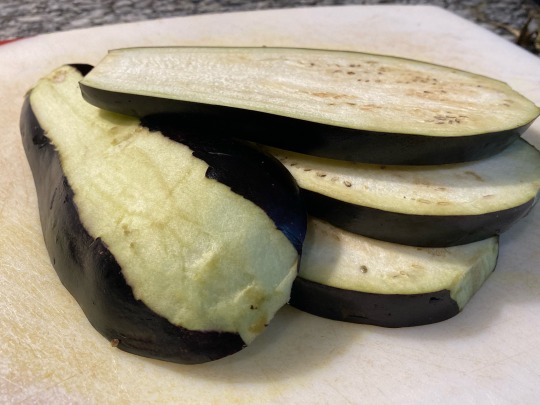
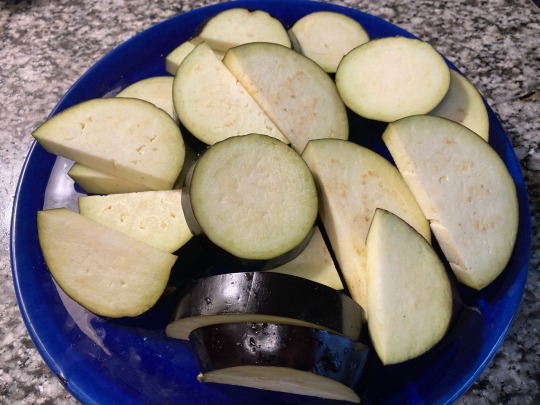
Cut the other eggplant (or both eggplants) widthwise into coins and half-coins.
4. Sprinkle eggplant slices with salt on both sides and leave for 10-15 minutes to release water.
5. Peel potatoes and cut in 1/4" (1/2 cm) slices.

6. Heat about an inch of oil in a deep skillet or wok on medium (a potato slice dropped in should immediately form bubbles). Fry the potato slices until golden brown, then remove onto a paper-towel-lined plate or wire cooling rack.
7. Press eggplant slices on both sides with a towel to remove moisture. Fry in the same oil until translucent and golden brown, then remove as before.
Fry other vegetables (except for tomato, chickpeas, and peas) the same way, if using.
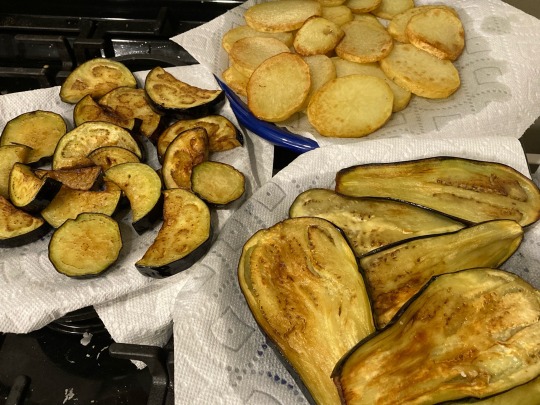
8. Drain rice. Whisk bouillon, salt, and ground spices into several cups of hot water.
9. Prepare a large, thick-bottomed pot with a circle of oiled parchment paper (or with a layer of sliced tomatoes). Add ground meat, if using. Layer widthwise-sliced eggplants into the pot, followed by potatoes. Place longitudinally sliced eggplants around the sides of the pot, large side up.
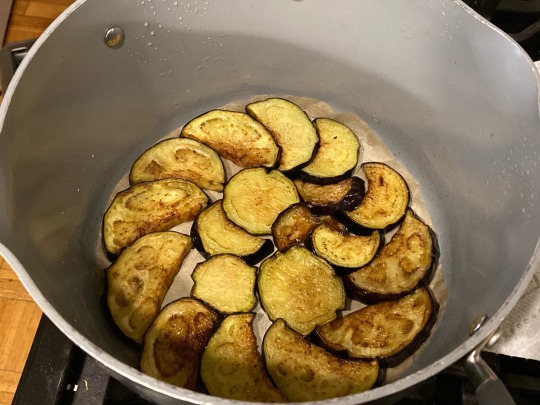
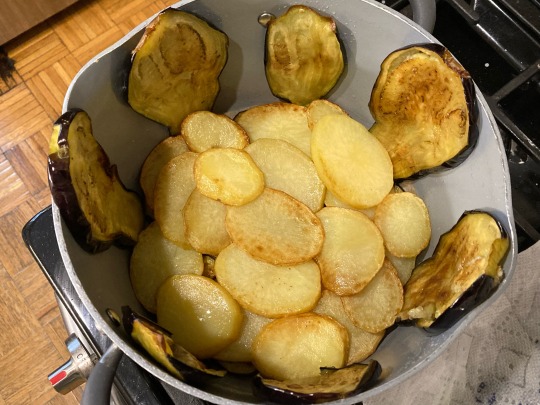
10. Add rice and pack in. Fold eggplant slices down over the rice, if they protrude.
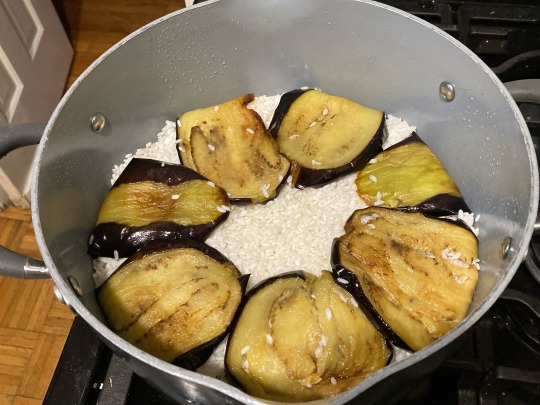
11. Pour broth into the pot, being careful not to upset the rice. Add more water if necessary, so that the rice is covered by about an inch.
12. Heat on medium to bring to a boil. Reduce heat to low, cover with a closely fitting lid, and cook 30 minutes.
13. If rice is not fully cooked after 30 minutes, lightly stir and add another cup of water. Re-cover and cook another 15 minutes. Check again and repeat as necessary.
14. Allow maqluba to rest for half an hour before flipping for best results. Place a large platter upside-down over the mouth of the pot, then flip both over in one smooth motion. Tap the bottom of the pot to release, and leave for a few minutes to allow the maqluba to drop.
15. Slowly lift the pot straight up, rotating slightly if the sides seem stuck.
16. Top with fried seitan lamb, chopped parsley, and fried pine nuts or almonds, as desired.
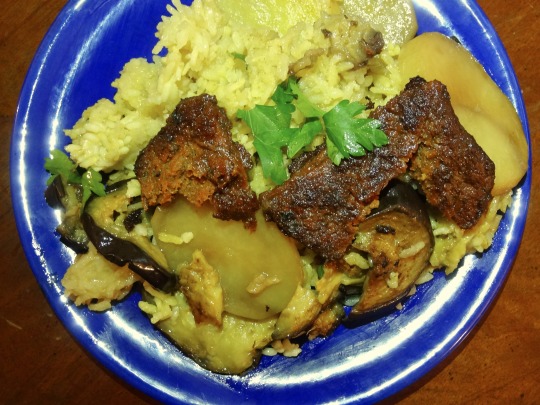
368 notes
·
View notes
Text
لا اخفي سرا انا من عشاق الطبيخ في هذا الوقت شويه رز و حتة لحمة و شويه بسلة أو فاصوليا ببقي نايم شبعان و آخر انبساط
24 notes
·
View notes
Text
انهارده عيد ميلاد والدتي العزيزة
افتكر أن ماما أول يوم دراسة كانت بتخلي البيت جنة وبتعرف تهيئة لينا بحيث نرجع نرتاح . ندخل البيت نقلع الكوتشيهات. الشربات في الغسالة ندخل الحمام نلاقي ريحته فلة والفوط متعلقة وندخل اواضنا نلاقي البيجامة عل السرير أو الترنج . وريحه الطبيخ عمال يفحفح ودايما كانت تخلي حلة الرز اخر حاجة عشان يبقي سخن وتأكلنا وبعد كدا كل واحد يشوف حاله
وخير متاع الدنيا الزوجة الصالحة وابونا اختار لنا ست صالحة ونفسيتها سوية وروحها طاهرة خلت البيت جنة الحمد لله رب العالمين...كل سنة وانتى طيبة و بخير ديما يا ماما وعقبال متشوفي ولادي و ولاد ولادي
11 notes
·
View notes
Text
عمارتنا ف الوقت ده وإنت طالع تشم ريحة الطبيخ عند كل عتبة ماشاءالله ، ربنا يديم نعمه على الناس
3 notes
·
View notes
Text
.
.
.
كلمة ( يامعود) :
يستخدم العراقيون كلمة يامعود بكثرة،من أين جاءت هذه التسمية، وما هو معناها؟؟؟
جاءت هذه التسمية من مدينة السماوة مدينة الكرم والطيب مدينة ثورة العشرين مدينة الثوار. شعلان أبو الجون ومحسن ابو الطبيخ...
وغيرهم
وقصة هذه الكلمة جاءت من أحد شيوخ القبائل في مدينة السماوة ؛ أعتاد على فعل الخيرات والمَكرُمات بين أهله وقبيلته ولكونه رئيس قبيلة يُطلق عليه عدة تسميات وألقاب منها
( المحفوظ.... وطويل العمر... والمعزوز.. والكليط... الخ ) من الالقاب التي تليق به..
أبناء القبيلة أرادوا ان يختاروا لهذا الرجل الطيب لقباً يليق بمكارم أخلاقه وكرمه العالي والمستمر
فاتفقوا ان يقولوا له( يامعود على فعل الخير ) او( يامعود على الخير ) أي المعتاد على هذه الأفعال والخصال الحميدة
ولكون المجتمع يحب الإختصار أصبحت مع مرور الايام "يامعود".
واستمرت ومنها جاءت هذه التسمية وأصبحت مشهورة بين الناس!!!
.
.
#راقتني
#كلمة_وأصلها
#عراقي
2 notes
·
View notes
Text
كلامي عن الطبيخ هنا بيحسسني إني لحوست المكان 🌝
9 notes
·
View notes
Text
أحلى لحظات حياتي هي الوصول لآخر اليوم.. الطبيخ خلص المواعين انتهت الترويق خلص ببقى حاسه إن في حمل اتشال من على قلبي والله، خصوصاً إن اليوم بيجري بسرعة اوييي مفيش مجال للهدنة
5 notes
·
View notes
Text
كل مرحلة جديدة بتحتاج فترة من العشوائية لحد التأقلم بس ده بيختلف من شخص للتاني وأنا للأسف باخد وقت كبير وبتحسس لأي متغيرات ..
حولت كلية جديدة .. قعدت ٣ سنين بخبط فيها وبشيل في مواد واعيد سنتين! لحد ماتأقلمت وفهمت نظامها ونظام دكاترتها.. عياط عياط وكره للدنيا ورغبات في الانتحار والدنيا مقفلة.. مش عارفه اتعامل مع حد وحمل كبير .. دلوقتي بحب الكلية جدا وبشوف اني تطويلي فيها ده كان له فايدة احسن من لما اتخرج وانا مش عارفه حاجة ومحتاسة .. وحاليا محددة اهدافي وغايتي منها الحمدلله
لما اتجوزت خدت سنة كاملة عقبال ماتأقلمت.. حاجات كتير مكنتش بعرف اعملها .. وقت بيعدي بسرعة وانا لسه مخلصتش المواعين .. يمكن اراكمها باليومين كمان عشان مضغوطة من كترها .. الطبيخ كان بياخد مني النهار كله ويمكن يطلع مش حلو كمان وده كان بيحبطني اكتر .. دلوقتي في ساعة او ساعتين بالكتير بقلب كل حاجة منغير ماتبوظ وباقي اليوم بتاعي .. التنضيف وترتيب البيت كل ده كان متعب جدا .. دلوقتي بقى شيء روتيني بعمله وانا مغمضة
بعدها قررنا نخلف خلاص .. كنت في الاول مشتتة .. فترة الحمل ناس كتير بيشتكوا منها .. بس شوية توعية ومتابعة قدرنا نظبطها وبقت فترة جميلة الحمدلله (ماعدا اول ٣ شهور 🤢)
وبعد مااولد عارفه ان هخبط كتير اوي وهحتاس وهرجع لنفس عشوائية اول الجواز ويمكن اكتر ... بس هتعدي
المهم اتعلمت اني مجلدش نفسي طالما بحاول.. محدش بيجري ورايا .. وهيجي وقت واتأقلم وابقى اكتر تنظيم وأقل تشتت وتوهان ومحدش بيتولد كامل وعارف كل حاجة او مر بكل التجارب .. كلها تجارب جديدة طارئة .. يمكن عشان كده بنخاف نخوضها .. بس لما بنعدي منها بنلاقي ايه ده الموضوع طلع حلو اهو!
5 notes
·
View notes
Text
وكأن نعته لي سُبه!!!☺️
من ضمن التعليقات التي كتبها أحد الأشخاص على الصفحة قبل أربعة أيام، لما أخذته الحمية دفاعا عن الشخص الذي قصدته ..
كتب هذا الشخص وقصده ونيته وكأنه يسُبني أو يشتمني على هذا النحو:
هذا لما خَرجتِ من المطبخ، بدأت تكتبين في هذا، فياريتك بقيت في المطبخ،ولم تخرجي منه وهذا مكانكن أنتن النساء ولاتصلحن لغيره!!!
وأنا أتكلم عن إنسان مثقف وليس بجاهل..
هذا معنى رسالته..وإن كانت في صياغتها مختلفة..
ماعلينا: شرعت فورا بالرد عليه، لكن بعد عدة ثواني توقفت، وتراجعت ومسحت تعليقه وتعليقي..
ألا يعلم هذا الشخص أنني من الجيل الذي يسمى الدقة القديمة☺️ وبحب جدا وجودي في المطبخ!
ألا يعلم من كتاباتي أنني ممن أقضي غالب نهاري في المطبخ
ولا أدخل إلى باقي غرف البيت إلا للتنظيف والكنس والترتيب والكوي!!!☺️
ألا يعلم أنني من السيدات التي لازلن متمسكين بخدمة الزوج والأولاد ويستمتعن بذلك..
بل أقول واعترف هاهنا أنني أقضي 90% من يومي في المطبخ ، ببساطة لأنه عالمي الذي أبحر فيه..
أنا والله لست سيدة موديرن!!! أو عصرية!! وتتبع الموضة..
أبدا والله ..
ألا يعلم أنني أقضي الأيام غالبا في البيت، و لا أخرج من بيتي، إلا لضرورة، أو لتغيير الهواء الذي اتنفسه يوميا من الطبيخ والحلويات..فهذا عشقي والله.. وهذا ملعبي وعريني ومحترفي، مطبخي☺️ ..
ألا يعلم أنني أحيانا قد تمر الأيام أو الأسابيع أو حتى شهرا كاملا ولا أخرج من البيت بتاتا!!!
ولست نادمة..
فلست مولعة بالأسواق ولا بصيحات الموضة ولا ألهث وراء التسوق.. ولا أخرج الا لشراء حاجتي الضرورية!! وضرورة قصوى..
ياسيدي والله أنا سيدة دقة قديمة حرفيا، وبحب البيت وخصوصا المطبخ، فسعادتي استشعرها عندما يعود أهل بيتي مسرعين إلى المطبخ، بعد يوم دراسي طويل أو عمل مُتعب، سائلين: شو طابخة اليوم.. جوعانين..!!
رح قلك على سر صغير: أنا عندي مبدأ أني لا أقارن حياتي بأي أحد، فلا أنظر للأعلى مني!!
واعتبر من الذين هم أقل مني، وبذلك راضية وأشكر الله ليل ونهار على وجود نعمة السقف الذي فوقي، ونعمة البنتين اللواتي أكرمني الله بهن، أنا راضية عن كل شيء برغم الأشياء والأحلام التي كنت أراها يوما ما تجارة رابحة، لو امتلكتها..وحصلتها.. واستبان لي مع الأيام حكمة الله في اختياره لي ...وسوء معتقدي.. فأقول لك هاهنا: أنا ست قديمة الطراز جدا وعتيقة بأفكاري!!!
ألا تعلم أنني أحب حي��ان بيتي ومطبخي ورائحته وأعشق عبق رائحة ماء الزهر والورد والشوكولا والفانيليا وورق العنب والمحاشي التي تفوح منه ومني☺️🌿 ..
أنا ياسيدي من عشاق المطبخ وسيدة دقة قديمة حرفيا، وأضيف أخوتي اللواتي هن من لحمي ودمي ومن أمي وأبي لسن مثلي برغم أنهن في بلدي الأصلي!!
فتخيل أنني في مهجري وغربتي ومتمسكة في هذا العشق المطبخي..
وتخيل زيادة أكثر أنني أدرس وأذاكر وأستدرك في مطبخي وأسمع الدروس والخطب من مطبخي ...
وأفرغ المحاضرات الطوال من مطبخي ...
وأكتب وانشر الفوائد من مطبخي ...
الطبخ في كفة اليمين و الدروس والمقررات في الكفة الأخرى..
أنا ياسيدي: سيدة قديمة الطبع والطراز، ودقة قديمة جدا، من سيدات عصر الجدات.. ولي الفخر والله ..
الأستاذة فاطمة عبد الكريم
2 notes
·
View notes
Note
Kebab (UK: /kɪˈbæb/, US: /kɪˈbɑːb/; Arabic: كباب, kabāb, [kaˈbaːb]; Turkish: kebap, [cebɑp]) or kabob (North American) is a type of cooked meat dish that originates from cuisines of the Middle East. Many variants of the category are popular around the world, including the skewered shish kebab and the doner kebab with bread.
Kebabs consist of cut up or ground meat, sometimes with vegetables and various other accompaniments according to the specific recipe. Although kebabs are typically cooked on a skewer over a fire, some kebab dishes are oven-baked in a pan, or prepared as a stew such as tas kebab.[1][2] The traditional meat for kebabs is most often lamb meat, but regional recipes may include beef, goat, chicken, fish, or even pork (depending on whether or not there are specific religious prohibitions).
History
In Ibn Sayyar al-Warraq's 10th-century Baghdadi cookbook Kitab al-Tabikh (Arabic: كتاب الطبيخ), a compendium of much of the legacy of Mesopotamian, Persian, and Arab cuisine, there are descriptions of kabāb as cut-up meat, either fried in a pan or grilled over a fire.[3]
However, while the word kebab or shish kebab may sometimes be used in English as a culinary term that refers to any type of small chunks of meat cooked on a skewer,[1] kebab is mainly associated with a diversity of meat dishes that originated in the medieval kitchens of Persia and Anatolia.[4] Though the word has ancient origins, it was popularized in the West by Turks to refer to this range of grilled and broiled meat, which may be cooked on skewers, but also as stews, meatballs, and other forms.[1][4] This cuisine has spread around the world, in parallel with Muslim influence.[1] According to Ibn Battuta, a Moroccan traveller, kebab was served in the royal houses during the Delhi Sultanate (1206–1526 CE), and even commoners would enjoy it for breakfast with naan.[5] Kebab dishes have been adopted and integrated with local cooking styles and innovations, from the now-ubiquitous doner kebab fast food, to the many variations of shish kebab, such as the satays of Southeast Asia.[1]
The word kebab likely came to English in the late 17th century from the Arabic kabāb, partly through Hindustani, Persian and Turkish.[6][7] According to linguist Sevan Nişanyan, the Turkish word kebap is also derived from the Arabic word kabāb, meaning roasted meat. It appears in Turkish texts as early as the 14th century, in Kyssa-i Yusuf (the story of Joseph), though still in the Arabic form. Nişanyan states that the word has the equivalent meaning of 'frying, burning' with kabābu in the old Akkadian language, and kbabā כבבא in Aramaic.[8] In contrast, food historian Gil Marks says that the medieval Arabic and Turkish terms were adopted from the Persian kabab, which probably derived from the Aramaic.[4]
The American Heritage Dictionary also gives a probable East Semitic root origin with the meaning of 'burn', 'char', or 'roast', from the Aramaic and Akkadian.[9] The Babylonian Talmud instructs that Temple offerings not be kabbaba (burned).[4] These words point to an origin in the prehistoric Proto-Afroasiatic language: *kab-, to burn or roast.[10]
Varieties by region
This section needs additional citations for verification. Please help improve this article by adding citations to reliable sources. Unsourced material may be challenged and removed. Find sources: "Kebab" – news · newspapers · books · scholar · JSTOR (February 2018) (Learn how and when to remove this template message)
For a list of kebab variants, see List of kebabs.
In most English-speaking countries, a kebab may be the classic shish kebab or souvlaki – small cubes of meat cooked on a skewer[1][6] – or, in North America where it is better known as gyros where as outside North America fast-food is known as doner kebab.[11][6][4] By contrast, in Indian English, Bangladeshi English, Pakistani English[12][13] and in the languages of the Middle East, other parts of Asia, and the Muslim world, a kebab is any of a wide variety of grilled meat dishes. Some dishes ultimately derived from Middle Eastern kebab may have different names in their local languages, such as the Chinese chuan.
...
There are so many words I haven't heard of before here.
2 notes
·
View notes
Note
كيف العروس ♥️؟
تايهة في بحر الطبيخ والله 😹😹
الحمدلله في فضل ونعمة من ربنا، انتوا عاملين ايه؟
4 notes
·
View notes
Note
مساء الخير .
الناس اللي كانت مرهقة امبارح والنهاردة ولا حس ولا خبر يعني نسأل الله أن تكونوا سعداء وبخير حال وصحة ومفيش عجز في الامبولات ومقفلين محاضرنا تمام ولا في خناقات بسبب الطبيخ أو مع نجلاء 😂😂
𝕬...
لا خلاص بقي مبقاش ف نجلاء ذهبت مع الريح
2 notes
·
View notes
Text
بيجري وراها ذي البط كانه ناسي حلة الطبيخ علي النار أو يلحق اللبن قبل ما يفور 😅
1 note
·
View note
Text
عندما يكون “كب” الطبيخ أكثر فائدة من وجع البطن
في مثل شعبي كان منتشر زمان خاصة بين الفقراء بيقول .. “وجعك يا بطني ولا كب الطبيخ”. الفقراء زمان مكانش عندهم تلاجة فالأكل كان بيفسد بسرعة .. فلما الطبيخ تبدأ تظهر عليه علامات الفساد كان الفقراء بيختاروا أنهم يكلوه رغم علمهم إنه هيوجع بطنهم بدل من التخلص منه! المثل ده مثال لإحدى المغالطات المنطقية المشهورة باسم مغالطة التكلفة الغارقة Sunk Cost Fallacy ودي من أكتر المغالطات اللي بنقع فيها كلنا…
0 notes
Text
أن تكون شاعراً..
#حانة_الشعراء قصيدة للشاعر #عبد_الرزاق_الصغير
اللوحة: الفنان المكسيكي دييغو ريفيرا عبد الرزاق الصغير زوجتي لا تهتم بالشعر والرواية لا تقرأ، تكتب بعض وصفات الطبيخ التي لا تستطيع نسخها في هاتفها لا تعرف مثلا جون كيتس أو آنا أخماتوفا أو أي شاعرة عربية مثل غادة السمان كنت قد وصلت في ديوان عدنان الصائغ لقصيدة دبق لم توربني بعد النافذة المواربة حين كانت الريح قوية ورفيقة عمري تعرض علي البيض المسلوق والفلفل الحار وشرائح الطماطم…
0 notes
